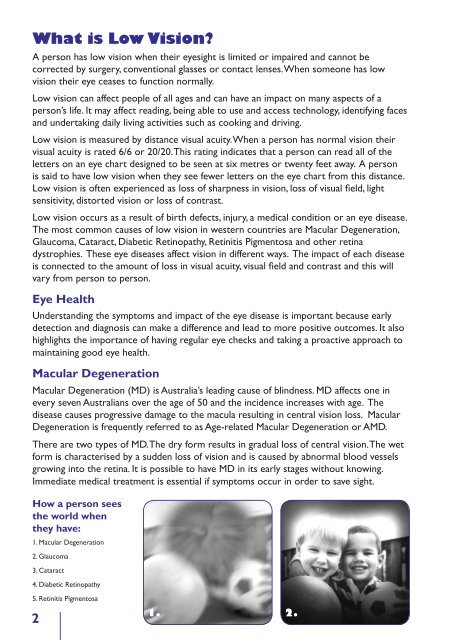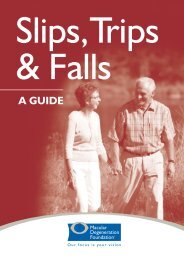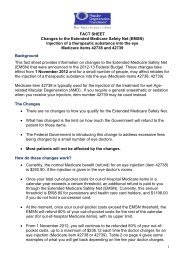Family, Friend and Carer - A Guide - Macular Degeneration ...
Family, Friend and Carer - A Guide - Macular Degeneration ...
Family, Friend and Carer - A Guide - Macular Degeneration ...
You also want an ePaper? Increase the reach of your titles
YUMPU automatically turns print PDFs into web optimized ePapers that Google loves.
What is Low Vision?A person has low vision when their eyesight is limited or impaired <strong>and</strong> cannot becorrected by surgery, conventional glasses or contact lenses. When someone has lowvision their eye ceases to function normally.Low vision can affect people of all ages <strong>and</strong> can have an impact on many aspects of aperson’s life. It may affect reading, being able to use <strong>and</strong> access technology, identifying faces<strong>and</strong> undertaking daily living activities such as cooking <strong>and</strong> driving.Low vision is measured by distance visual acuity. When a person has normal vision theirvisual acuity is rated 6/6 or 20/20. This rating indicates that a person can read all of theletters on an eye chart designed to be seen at six metres or twenty feet away. A personis said to have low vision when they see fewer letters on the eye chart from this distance.Low vision is often experienced as loss of sharpness in vision, loss of visual field, lightsensitivity, distorted vision or loss of contrast.Low vision occurs as a result of birth defects, injury, a medical condition or an eye disease.The most common causes of low vision in western countries are <strong>Macular</strong> <strong>Degeneration</strong>,Glaucoma, Cataract, Diabetic Retinopathy, Retinitis Pigmentosa <strong>and</strong> other retinadystrophies. These eye diseases affect vision in different ways. The impact of each diseaseis connected to the amount of loss in visual acuity, visual field <strong>and</strong> contrast <strong>and</strong> this willvary from person to person.Eye HealthUnderst<strong>and</strong>ing the symptoms <strong>and</strong> impact of the eye disease is important because earlydetection <strong>and</strong> diagnosis can make a difference <strong>and</strong> lead to more positive outcomes. It alsohighlights the importance of having regular eye checks <strong>and</strong> taking a proactive approach tomaintaining good eye health.<strong>Macular</strong> <strong>Degeneration</strong><strong>Macular</strong> <strong>Degeneration</strong> (MD) is Australia’s leading cause of blindness. MD affects one inevery seven Australians over the age of 50 <strong>and</strong> the incidence increases with age. Thedisease causes progressive damage to the macula resulting in central vision loss. <strong>Macular</strong><strong>Degeneration</strong> is frequently referred to as Age-related <strong>Macular</strong> <strong>Degeneration</strong> or AMD.There are two types of MD. The dry form results in gradual loss of central vision. The wetform is characterised by a sudden loss of vision <strong>and</strong> is caused by abnormal blood vesselsgrowing into the retina. It is possible to have MD in its early stages without knowing.Immediate medical treatment is essential if symptoms occur in order to save sight.How a person seesthe world whenthey have:1. <strong>Macular</strong> <strong>Degeneration</strong>2. Glaucoma3. Cataract4. Diabetic Retinopathy5. Retinitis Pigmentosa21. 2.







